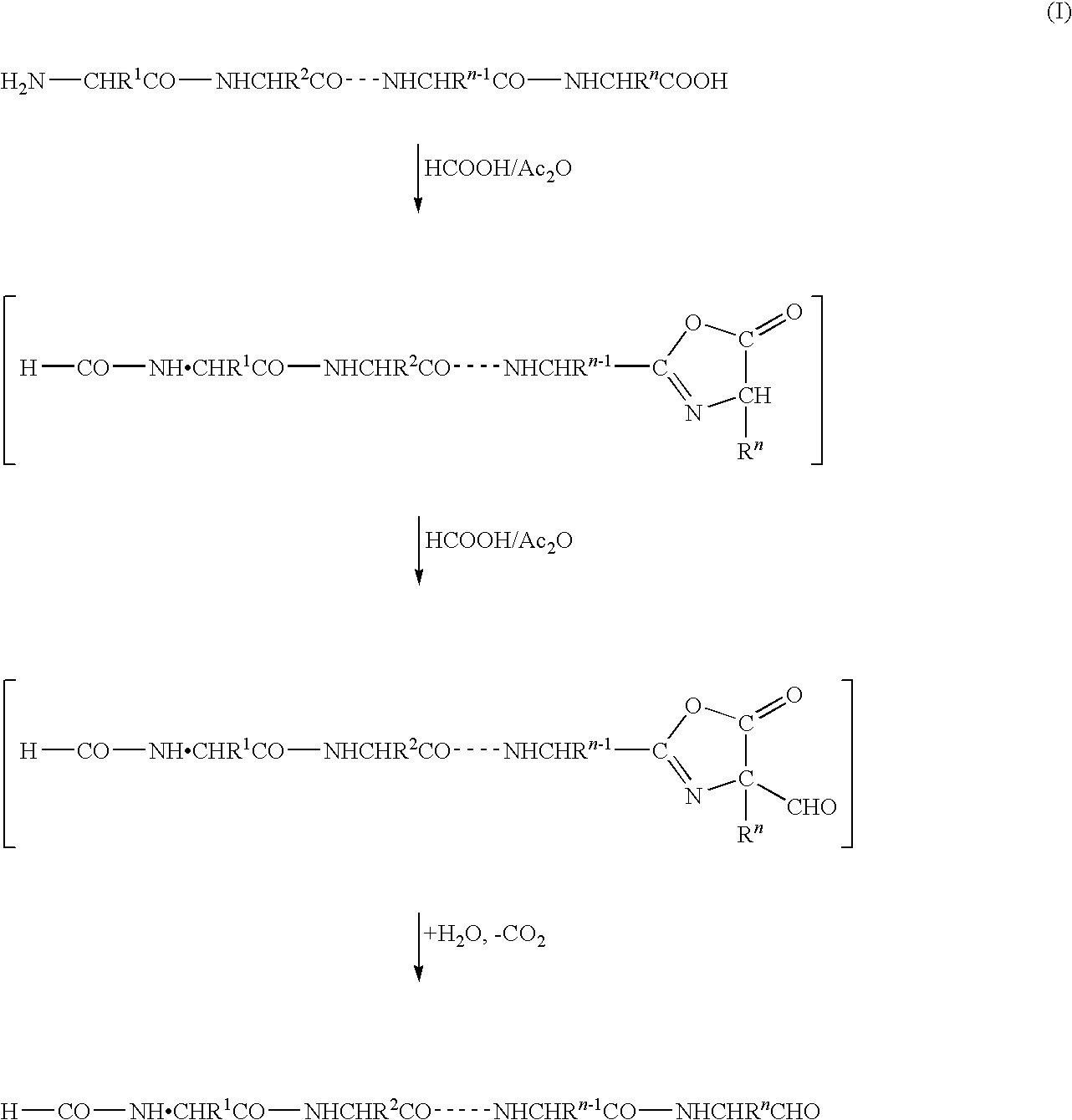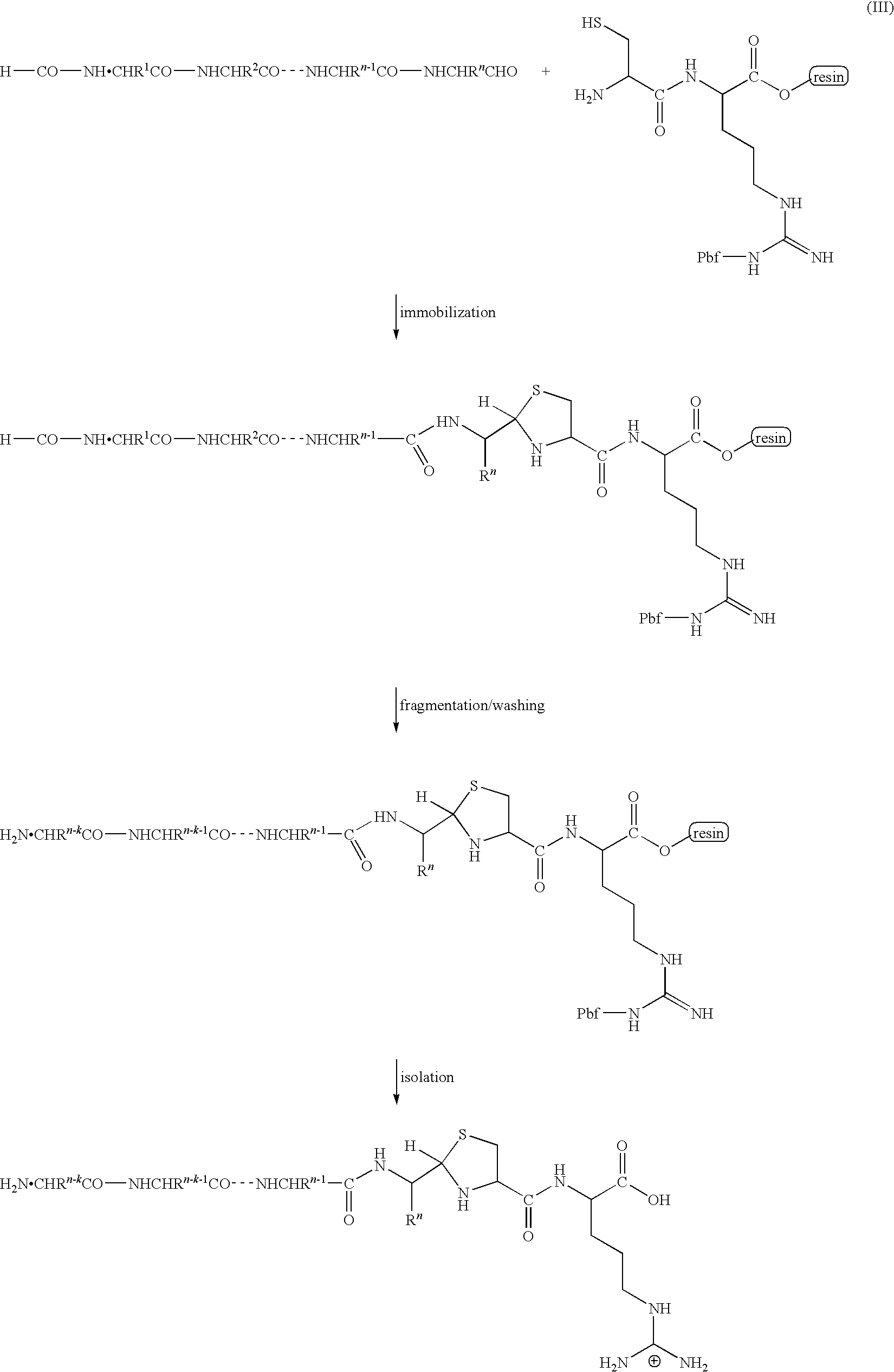C-terminus modification method, c-terminus immobilization method and analysis method for protein or peptide
a technology of c-terminus and modification method, which is applied in the field of protein/peptide chemistry, can solve the problems of unrealistic necessity for preceding protection of all side-chain functional groups of the above amino acids, and achieve the effects of easy and efficient modification of the c-terminus, easy and convenient identification, and reduced reaction efficiency
- Summary
- Abstract
- Description
- Claims
- Application Information
AI Technical Summary
Benefits of technology
Problems solved by technology
Method used
Image
Examples
example 1
[0114]In this example, a protein RCM-STI obtained by reduction / carboxymethylation (RCM) of all cysteine residues of soybean trypsin inhibitor (STI) was used as a sample protein. The C-terminal carboxyl group of the sample protein was converted into an aldehyde group followed by reacting the product with 2-hydrazino-2-imidazoline to generate hydrazone.
[0115]RCM-STI, 3.2 mg (0.15 μmol), was dissolved in 0.5 ml of a mixture (formylation reagent) of formic acid and trifluoroacetic anhydride in equal volumes, to give a mixed solution, and then 50 μl of a solution of pentafluorophenol 3 mg (15 μmol, 100 equivalents to STI) in formic acid was added thereto, and the mixture was heated at 60° C. for 20 minutes. After the reaction was finished, the reaction solution was concentrated under reduced pressure and evaporated to dryness. A small amount of toluene was added to the resulting residue which was then concentrated under reduced pressure and evaporated to dryness; this procedure was condu...
example 2
[0118]In this example, a mass spectrum was obtained in the same manner as in Example 1 except that a mixture of formic acid and acetic anhydride in equal volumes was used as the formylation reagent. The resulting mass spectrum is shown in FIG. 2. According to the analysis results in FIG. 2, the same peak of 1387.7 (m / z) was detected even when acetic anhydride was used in place of trifluoroacetic anhydride in the above example in C-terminal activation.
[0119]The results (FIG. 1) in Example 1 and the results (FIG. 2) in Example 2 show that in both the examples, a C═N bond of 2-imidazolino-2-hydrazone, derivatized from an aldehyde group of Leu that is the C-terminal amino acid of the objective C-terminal peptide, is free of hydrolysis with chymotrypsin, although there is a difference therebetween in the efficiency of conversion of the carboxyl group into an aldehyde group. That is, if the modified group is introduced via an amide bond or an ester bond without converting the carboxyl gro...
example 3
[0120]In this example, a mass spectrum was obtained in the same manner as in Example 1 except that a protein RCM-Cyt. c obtained by reduction / carboxymethylation (RCM) of all cysteine residues of horse cytochrome c (Cyt. c) was used as a sample protein. The resulting mass spectrum is shown in FIG. 3. According to the analysis results in FIG. 3, a peak of 785.6 (m / z) was detected with the maximum intensity. From this result, it was confirmed that an ion [M+H2]+ having a hydrogen molecule added to an ion (M+) of a peptide derivative (theoretical mass: 783.42) obtained by conversion of the objective C-terminal peptide, that is, Lys(For)-Lys(For)-Ala-Thr-Asn-Glu-H (SEQ ID NO: 2), by the 2-imidazolino-2-hydrazone derivatization had been formed. Here, Glu-H indicates that the carboxyl group of C-terminal glutamic acid is converted into an aldehyde group, and Lys(For) indicates that an ε-amino group of lysine is formylated.
[0121]The observed MALDI peak [M+H2]+ having a mass number higher by...
PUM
| Property | Measurement | Unit |
|---|---|---|
| pH | aaaaa | aaaaa |
| pH | aaaaa | aaaaa |
| molar ratio | aaaaa | aaaaa |
Abstract
Description
Claims
Application Information
 Login to View More
Login to View More - R&D
- Intellectual Property
- Life Sciences
- Materials
- Tech Scout
- Unparalleled Data Quality
- Higher Quality Content
- 60% Fewer Hallucinations
Browse by: Latest US Patents, China's latest patents, Technical Efficacy Thesaurus, Application Domain, Technology Topic, Popular Technical Reports.
© 2025 PatSnap. All rights reserved.Legal|Privacy policy|Modern Slavery Act Transparency Statement|Sitemap|About US| Contact US: help@patsnap.com



